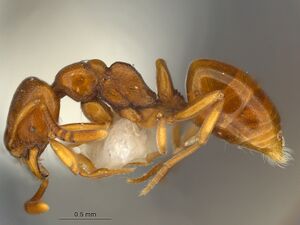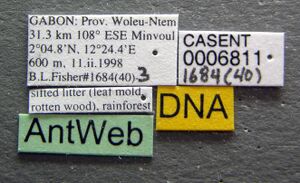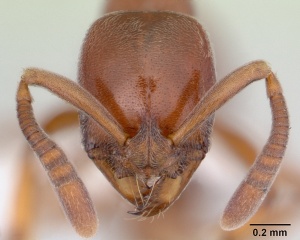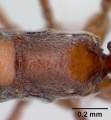Asphinctopone silvestrii
| Asphinctopone silvestrii | |
|---|---|

| |
| Scientific classification | |
| Kingdom: | Animalia |
| Phylum: | Arthropoda |
| Class: | Insecta |
| Order: | Hymenoptera |
| Family: | Formicidae |
| Subfamily: | Ponerinae |
| Tribe: | Ponerini |
| Genus: | Asphinctopone |
| Species: | A. silvestrii |
| Binomial name | |
| Asphinctopone silvestrii Santschi, 1914 | |
| Synonyms | |
| |
All examples of this species were retrieved from samples of leaf litter or topsoil, or in the rotting trunks of fallen trees, small pieces of dead wood, a rotting banana stem on the forest floor, and once from a termitary. (Bolton and Fisher 2008)
Identification
silvestrii = with the propodeum in profile the dorsum with pubescence extremely scanty, almost absent. Side of propodeum with scattered punctures, the spaces between them usually smooth (Guinea, Ivory Coast, Ghana, Nigeria, Cameroun, Gabon, Central African Republic).
- Asphinctopone silvestrii
Asphinctopone differens = With the propodeum in profile the dorsum with a pelt of erect, weakly curved pubescence. Side of propodeum entirely densely irregularly sculptured (Central African Republic)
- Asphinctopone differens
Asphinctopone pilosa = 1) larger size, 2) stronger and much more extensive sculpturation and denser pubescence, 3) differently shaped mesonotum and propodeum, 4) far less strongly impressed promesonotal suture and metanotal groove, 5) terminal four, rather than three, antennal segments forming a weak club, 6) more strongly squamiform petiole, which is also more arcuate in dorsal view, 7) less developed clypeal structure (in Asphinctopone silvestrii and Asphinctopone differens the median clypeal lobe is bounded by distinct sharp angles, is distinctly though shallowly concave on either side of the more acutely rounded median projection and is relatively broader at about 0.40 x HW), 8) the lack of a tooth-like process on the inner basal margin of the mandible and 9) darker colour.
Keys including this Species
Distribution
Latitudinal Distribution Pattern
Latitudinal Range: 6.5° to 5.5°.
| North Temperate |
North Subtropical |
Tropical | South Subtropical |
South Temperate |
- Source: AntMaps
Distribution based on Regional Taxon Lists
Afrotropical Region: Cameroun, Central African Republic, Gabon, Ghana, Guinea, Ivory Coast, Nigeria (type locality).
Distribution based on AntMaps
Distribution based on AntWeb specimens
Check data from AntWeb
Countries Occupied
| Number of countries occupied by this species based on AntWiki Regional Taxon Lists. In general, fewer countries occupied indicates a narrower range, while more countries indicates a more widespread species. |

|
Estimated Abundance
| Relative abundance based on number of AntMaps records per species (this species within the purple bar). Fewer records (to the left) indicates a less abundant/encountered species while more records (to the right) indicates more abundant/encountered species. |

|
Biology
Asphinctopone is one of the most rarely collected and least known small ponerine genera of the Afrotropical region. Specimens are seldom found and most samples recovered consist of only one or two workers. As a measure of its rarity, a survey of leaf litter in Ghana (Belshaw & Bolton, 1994) recorded 43,824 individual ants, of which only 5 (about 0.01%) were Asphinctopone. Despite this rarity, the genus is widespread in wet forest zones in leaf litter, topsoil, pieces of rotten wood and rotting vegetation on the forest floor. One worker has been found foraging in a fallen, abandoned termitary (Dejean et al., 1996). Beyond this nothing is known of its biology. Its specialised morphology implies that it may be prey-specific, but in reality its victims remain unknown. (Bolton and Fisher 2008)
Castes
Worker
   
| |
| . | Owned by Museum of Comparative Zoology. |
Images from AntWeb
   
| |
| Worker. Specimen code casent0178220. Photographer April Nobile, uploaded by California Academy of Sciences. | Owned by CAS, San Francisco, CA, USA. |
   
| |
| Worker. Specimen code casent0406788. Photographer April Nobile, uploaded by California Academy of Sciences. | Owned by CAS, San Francisco, CA, USA. |
   
| |
| Worker. Specimen code casent0406793. Photographer April Nobile, uploaded by California Academy of Sciences. | Owned by CAS, San Francisco, CA, USA. |
   
| |
| Specimen code casent0417784. . | |
   
| |
| Worker. Specimen code casent0006811. Photographer April Nobile, uploaded by California Academy of Sciences. | Owned by CAS, San Francisco, CA, USA. |
     
| |
| Worker. Specimen code casent0178222. Photographer April Nobile, uploaded by California Academy of Sciences. | Owned by CAS, San Francisco, CA, USA. |
Nomenclature
The following information is derived from Barry Bolton's Online Catalogue of the Ants of the World.
- silvestrii. Asphinctopone silvestrii Santschi, 1914d: 318, fig. 6a,b (w.) NIGERIA.
- Type-material: holotype worker.
- Type-locality: Nigeria: Olokemeji, xii.1912 (F. Silvestri).
- Type-depository: unknown (not in DEUN or NHMB, presumed lost (Bolton & Fisher, 2008a: 57)).
- Bolton & Fisher, 2008a: 58 (q.).
- Status as species: Wheeler, W.M. 1922a: 783; Bolton, 1995b: 75; Bolton, & Fisher, 2008a: 57 (redescription).
- Senior synonym of lamottei: Bolton & Fisher, 2008a: 57.
- Senior synonym of lucidus: Bolton & Fisher, 2008a: 57.
- Distribution: Cameroon, Central African Republic, Gabon, Ghana, Guinea, Ivory Coast, Nigeria.
- lamottei. Lepidopone lamottei Bernard, 1953b: 208, fig. 4 (w.) GUINEA.
- Type-material: holotype worker.
- Type-locality: Guinea (“French Guinea”): st. 22: Nion, 700m. (no collector’s name).
- [Note: data on holotype label: 22. Nyon For. (= Mt Nion For., Nimba Mts), 10.i.(1942), 8/2 (M. Lamotte).]
- Type-depository: MNHN.
- Combination in Asphinctopone: Brown, 1953h: 3.
- Status as species: Bolton, 1995b: 75.
- Junior synonym of silvestrii: Bolton & Fisher, 2008a: 57.
- lucidus. Asphinctopone lucidus Weber, 1949b: 7, figs. 5-7 (w.) CENTRAL AFRICAN REPUBLIC.
- Type-material: holotype worker.
- Type-locality: Central African Republic (“French Equatorial Africa”): Ubangi-Shari, Bas Mbomu, 5 mi. W. Bangassou, 12.iii.1948, #2210 (AMNH Central Africa Expd.) (N.A. Weber).
- Type-depository: AMNH.
- Status as species: Bolton, 1995b: 75.
- Junior synonym of silvestrii: Bolton & Fisher, 2008a: 57.
Unless otherwise noted the text for the remainder of this section is reported from the publication that includes the original description.
Description
Worker
Bolton and Fisher (2008) - TL 3.3-3.6, HL 0.78-0.83, HW 0.62-0.68, CI 78-83, SL 0.53-0.63, SI 85-93, PW 0.44-0.49, WL 0.96-1.06 (20 measured).
Mandible smooth and shining, unsculptured except for a few pits from which hairs arise. Eye small, maximum diameter 0.04 – 0.06 (OI 6 – 9), of only 5 – 8 poorly defined ommatidia. No distinct carina present between eye and base of mandible but a fine, weak cuticular crest present laterally that extends from the base of the mandible to above the eye, and terminates just behind the level of the eye. In full-face view posterior margin of head very shallowly convex. In the same view the scape, when laid straight back from its insertion, just fails to reach, to fractionally exceeds, the posterior margin. Dorsal surface of frontal lobes more strongly sculptured than remainder of head. Dorsum of head finely minutely punctulate; sides behind and below eyes with widely scattered, slightly larger punctures, the spaces between them smooth and shining. Promesonotal suture with short cross-ribs on the anterior margin of the mesonotal section. In profile the promesonotal suture and metanotal groove are both narrow and deeply impressed, so that the relatively short mesonotum forms a distinct, isolated convexity between them. Base of metanotal groove with short cross-ribs. Sulcus between mesonotum and mesopleuron present, the latter also with a transverse sulcus that divides it into anepisternum and katepisternum. Propodeal outline in profile slightly variable in shape: length and slope of dorsum shows variation, as does the degree of convexity of the dorsum and posterior angle, and the convexity of the posterior face, which varies from straight to very weakly convex. Propodeum unarmed and the small propodeal spiracle is low down on the side. Dorsum of pronotum and mesonotum sparsely sculptured with scattered small punctures, the density of the punctures weakly variable between individuals; punctures on propodeal dorsum more coarse. Side of propodeum with scattered punctures, the spaces between them generally smooth but sometimes with faint traces of interstitial sculpture; propodeal declivity unsculptured, weakly marginate laterally. Legs relatively short, maximum length of hind femur 0.60 – 0.67. Petiole surmounted by an unsculptured high, narrow scale that is convex dorsally (petiole maximum height 0.52 – 0.58; maximum thickness of scale in profile 0.14 – 0.18); scale in dorsal view broad (maximum width 0.36 – 0.39). Petiole with a short posterior peduncle that is equipped dorsally with three strong transverse carinae; rarely there is a trace of a fourth carina posteriorly. Subpetiolar process complex, as discussed above. First and second gastral tergites with small punctures, those on the second tergite usually somewhat more dense than on the first; spaces between punctures smooth and shining. Setae sparsely present on clypeus, very dense on pygidium and hypopygium, but otherwise all dorsal surfaces of head, mesosoma, petiole and gaster lack setae. Ventral surface of head with 1-2 short setae present, and a few on gastral sternites 1-3. Scapes, femora and tibiae have fine appressed pubescence but completely lack standing setae. Dorsal surfaces of head and mesosoma with sparse appressed pubescence, especially scanty on the dorsal propodeum where it is almost absent. Colour of individuals varies from reddish yellow to reddish brown.
Queen
Bolton and Fisher (2008) - TL 3.8, HL 0.79, HW 0.64, CI 81, SL 0.56, SI 88, PW 0.52, WL 1.08.
Slightly larger but otherwise very similar to the worker, with cephalic measurements falling within the same range. The extra size is accounted for by the mesosoma, which has a full set of flight sclerites, and a slightly larger gaster. Transverse sulcus on mesopleuron is more strongly developed than in worker. Head with three ocelli present; eye distinctly larger than in worker, its maximum diameter 0.16 (OI 25). Known from only a single dealate specimen (BMNH).
Type Material
Bolton and Fisher (2008):
Holotype worker, NIGERIA: Olokemeji, xii. 1912 (F. Silvestri) (not in DEUN or Naturhistorisches Museum, Basel, presumed lost; see note).
Asphinctopone lucidus Holotype worker, CENTRAL AFRICAN REPUBLIC (= “Fr. Equat. Africa” on data label): Ubangi-Shari, Bas Mbomu, 5 mi. W. of Bangassou, 12.iii.1948, #2210 (N.A. Weber) (American Museum of Natural History) [examined].
Lepidopone lamottei Holotype worker, GUINEA: 22. Nyon For. (= Nion, Mt. Nimba), 10.1.8/2 (Lamotte) (Musee National d'Histoire Naturelle) [examined].
Note. Conversations between Bruno Spinosa (DEUN) and Fabrizio Rigato (MSNM), as reported to Barry Bolton, have established that the holotype of A. silvestrii cannot be found in the Silvestri collection in Naples. Daniel Burckhardt (Naturhistorisches Museum, Basel) informs us that the silvestrii holotype has never been in the Santschi collection.
References
- Bolton, B. 1995b. A new general catalogue of the ants of the world. Cambridge, Mass.: Harvard University Press, 504 pp. (page 75, catalogue)
- Cantone S. 2018. Winged Ants, The queen. Dichotomous key to genera of winged female ants in the World. The Wings of Ants: morphological and systematic relationships (self-published).
- Esteves, F.A., Fisher, B.L. 2021. Corrieopone nouragues gen. nov., sp. nov., a new Ponerinae from French Guiana (Hymenoptera, Formicidae). ZooKeys 1074, 83–173 (doi:10.3897/zookeys.1074.75551).
- Hawkes, P. G. 2010. A new species of Asphinctopone (Hymenoptera: Formicidae: Ponerinae) from Tanzania. Zootaxa. 2480:27-36.
- Santschi, F. 1914d. Formicides de l'Afrique occidentale et australe du voyage de Mr. le Professeur F. Silvestri. Boll. Lab. Zool. Gen. Agrar. R. Sc. Super. Agric. 8: 309-385 PDF (page 318, fig. 6 worker described)
References based on Global Ant Biodiversity Informatics
- Belshaw R., and B. Bolton. 1994. A survey of the leaf litter ant fauna in Ghana, West Africa (Hymenoptera: Formicidae). Journal of Hymenoptera Research 3: 5-16.
- Belshaw R., and B. Bolton. 1994. A survey of the leaf litter ant fauna in Ghana, West Africa (Hymenoptera: Formicidae). Journal of Hymenoptera Research. 3: 5-16.
- Bernard F. 1953. La réserve naturelle intégrale du Mt Nimba. XI. Hyménoptères Formicidae. Mémoires de l'Institut Français d'Afrique Noire 19: 165-270.
- Bolton B., and B. L. Fisher. 2008. The Afrotropical ponerine ant genus Asphinctopone Santschi (Hymenoptera: Formicidae). Zootaxa 1827: 53-61.
- Lévieux J. 1972. Les fourmis de la savane de Lamto (Côte d'Ivoire): éléments de taxonomie. Bulletin de l'Institut Fondamental d'Afrique Noire. Série A. Sciences Naturelles 34: 611-654.
- Lévieux J. 1977. La nutrition des fourmis tropicales: V- Elements de synthèse. Les modes d'exploitation de la biocenose. Insectes Sociaux 24(3): 235-260.
- Medler J. T. 1980: Insects of Nigeria - Check list and bibliography. Mem. Amer. Ent. Inst. 30: i-vii, 1-919.
- Weber N. A. 1949. New ponerine ants from equatorial Africa. American Museum Novitates 1398: 1-9.
- Wheeler W. M. 1922. Ants of the American Museum Congo expedition. A contribution to the myrmecology of Africa. VIII. A synonymic list of the ants of the Ethiopian region. Bulletin of the American Museum of Natural History 45: 711-1004





